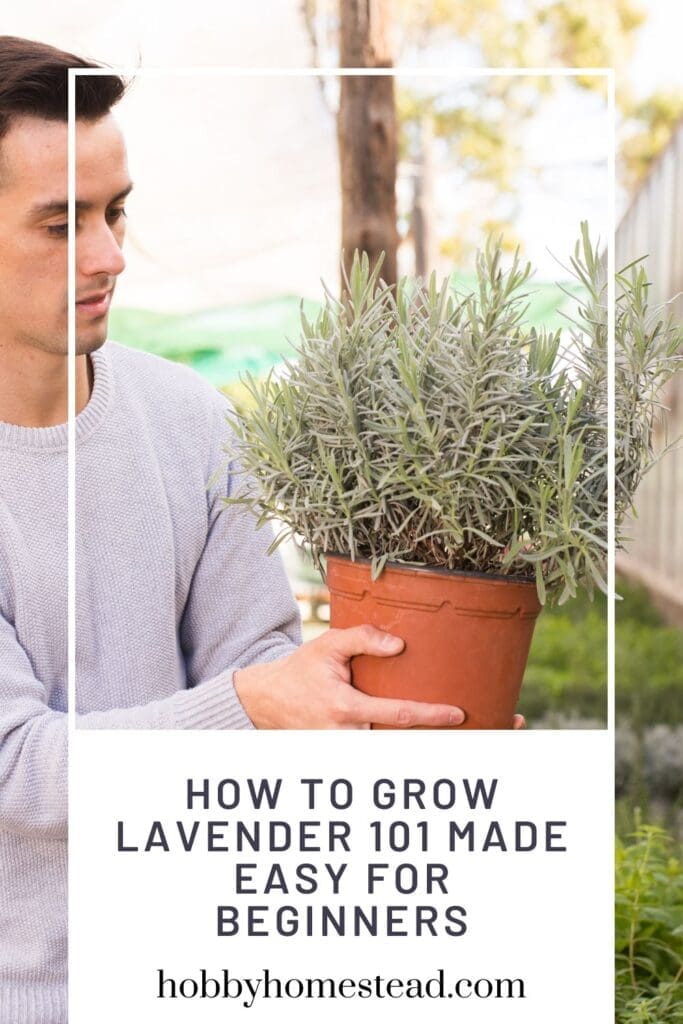Today we are sharing with you all our tips on how to grow lavender. A few years ago, my daughter and I visited a lavender festival at a charming farm just a few miles away. It was our first experience with lavender fields, and we were completely captivated.
The endless rows of lavender plants, their upright flower spikes swaying gently in the breeze, were not only stunning but also incredibly fragrant. We couldn’t resist bringing home a few plants to start our own little lavender patch, and it has been one of the most rewarding gardening endeavors we’ve undertaken.
Lavender is a beautiful and versatile plant that thrives in a variety of conditions and brings both aesthetic appeal and practical uses to your garden.
Whether you’re interested in lavender for its ornamental value, its ability to attract beneficial insects, or its culinary uses, growing lavender is simpler than you might think.
In this guide, we’ll cover everything you need to know. From choosing the best lavender varieties for your climate to planting, caring for, and harvesting this remarkable plant.

Table of contents
Why Grow Lavender?
Lavender is a great plant for gardeners of all skill levels. It’s hardy, low-maintenance, and offers numerous benefits. Lavender flowers are not only a treat for the senses but also attract beneficial insects like bees and butterflies to your garden.
It produces a delightful fragrance that can be used in everything from sachets to essential oils. Plus, it’s an excellent choice for rock gardens, herb gardens, or perennial gardens.
Types of Lavender
Choosing the right lavender variety is the first step to success. Here are some popular options.
English Lavender (Lavandula angustifolia). This is the best lavender for colder climates. It features gray-green foliage and is known for its sweet aroma and culinary uses.
French Lavender (Lavandula dentata). Ideal for warmer climates, this variety has a distinctive look with toothed leaves and long-lasting blooms.
Spanish Lavender (Lavandula stoechas). A great choice for humid climates, this variety features unique upright flower spikes with colorful bracts on top.
Hybrid Lavenders. These are lower-growing varieties that thrive in various conditions and offer fewer blooms but robust growth.

Planting Lavender
Lavender thrives in full sun and well-draining soil. Here’s how to plant lavender.
Choose the Right Spot. Select a location with excellent drainage and good air circulation. In heavy soils, consider planting in terracotta pots with drainage holes.
Prepare the Soil. Lavender prefers sandy soil or alkaline soil with minimal organic matter. If your soil is heavy, amend it with sand or gravel to improve drainage.
Planting Time. The best time to plant lavender is in early spring after the threat of frost has passed. For colder winters, planting in early fall can give young plants a head start.
Dig a Planting Hole. Dig a hole large enough to accommodate the root systems of your lavender plants. Space them about 2-3 feet apart for proper growth.
Transplanting Lavender Plants. When transplanting, dig a hole larger than the root ball. Place the plant upright in the hole and backfill it with soil and compost and add water.
Caring for Lavender
Lavender care is straightforward, but attention to a few details ensures thriving plants.
Watering. Lavender prefers the drier side. Use drip irrigation in humid regions to keep the leaves dry and prevent fungal diseases like powdery mildew.
Pruning. Prune approximately one-third of their height in late spring or early summer to encourage new growth and maintain a tidy shape.
Fertilizing. Avoid rich, organic matter; lavender thrives in poor soil.
Mulching. Use gravel or sand as mulch to improve drainage and prevent root rot.
Do I need to stake the plants?
The height of lavender plants ranges from 1 to 3 feet tall and wide. Therefore, no staking is required.

Common Problems and Solutions
Lavender is generally resilient, but here are some potential issues.
Root Rot. Avoid overwatering and ensure good drainage.
Spider Mites. Check the lower leaves and use natural remedies if needed.
Fungal Diseases. Improve air circulation and avoid wet foliage. Growing Lavender in Wisconsin
Growing lavender in Wisconsin requires a few specific considerations due to the state’s cold winters and sometimes heavy soils.
Here’s what you should keep in mind.
Choose Cold-Hardy Varieties. Opt for English lavender (Lavandula angustifolia) varieties, such as ‘Munstead’ or ‘Hidcote,’ as they are better suited to colder climates. These varieties can tolerate the colder temperatures typical in Wisconsin winters.
Provide Excellent Drainage. Wisconsin’s soil can be heavy and retain water, leading to root rot. To improve drainage:
- Plant lavender in raised beds or use terracotta pots with drainage holes.
- Amend the soil with sand or gravel to mimic the well-draining conditions lavender thrives in.
Winter Protection. Lavender doesn’t like cold temperatures combined with wet soil. Mulch around the base of the plant with straw or gravel to insulate the roots and improve drainage during the winter months. Avoid organic mulch that retains moisture.
Plant in Full Sun. Lavender requires full sun to thrive, even in colder regions. Choose a spot that gets at least 6-8 hours of sunlight daily.
When to Plant. Plant in early spring, after the threat of frost has passed, to give the plants time to establish strong root systems before winter.
Pruning. Prune lavender in early spring to remove any winter-killed branches and encourage new growth. Avoid heavy pruning in late summer or fall, as this can weaken the plant before winter.
Protection from Snow and Ice. If heavy snow or ice is expected, consider covering young plants with breathable frost cloth to prevent damage to their delicate branches.
Growing Lavender from Seed
Planting lavender from seed can be rewarding but requires patience and the right conditions to succeed. Here’s what you need to know about starting lavender from seed, including specific tips for Wisconsin gardeners:
General Tips for Growing Lavender from Seed
Cold Stratification. Lavender seeds have a hard outer coating and may benefit from cold stratification to improve germination rates.
- Place seeds in a damp paper towel inside a sealed plastic bag.
- Refrigerate for 2-4 weeks before planting.
Starting Indoors. Lavender seeds are slow to germinate and should be started indoors 10-12 weeks before the last frost.
- Use a well-draining seed-starting mix.
- Sow seeds on the surface of the soil and lightly cover them with a thin layer of soil or vermiculite.
Provide Warmth and Light
- Lavender seeds germinate best at temperatures between 65-75\u00b0F. Use a heat mat if needed.
- Place seedlings under a grow light or in a sunny windowsill for 12-16 hours a day.
Lavender seeds can take 2-4 weeks to germinate, sometimes longer. Keep the soil slightly moist but not soggy.
Transplanting Outdoors
Once seedlings are 2-3 inches tall and have a few sets of leaves, harden them off for about a week. Transplant them outdoors in early spring after the threat of frost has passed.
Starting From Seed Special Considerations for Wisconsin
Short Growing Season. Starting lavender seeds indoors is especially important in Wisconsin because the outdoor growing season is shorter. Aim to transplant seedlings outdoors by mid-May to maximize growth.
Lavender thrives in sandy or rocky soils. If your soil is heavy, amend it with sand, gravel, or lime to create the alkaline, well-draining conditions lavender prefers.
Since young plants are more vulnerable to cold temperatures, ensure they are planted in a sheltered area with good drainage. Consider mulching around the base to protect the roots during their first winter.
Lavender plants grown from seed often take 2-3 years to reach their full size and begin producing significant flowers. Ensure they have plenty of sunlight and good air circulation during this time.

Harvesting Lavender
The best time to harvest lavender flowers is in late summer when the buds are just starting to open. Cut flowers can be dried for crafts, sachets, or culinary uses. Always cut on a dry day and remove about one-third of the woody plant to encourage healthy regrowth.
Using Lavender
Lavender’s versatility extends beyond the garden.
Culinary Uses. Add dried lavender flowers to baked goods or teas.
Aromatherapy. Create essential oils or sachets for relaxation.
Décor. Use cut flowers in bouquets or as dried arrangements.
Growing lavender is a rewarding experience that adds beauty, fragrance, and functionality to your garden. With the right lavender varieties, proper care, and attention to planting conditions, you’ll enjoy lush, fragrant blooms for years to come.
Whether you’re planting lavender for its culinary uses, as a pretty plant in your garden, or as a great way to attract pollinators, this herb is an excellent choice for gardeners everywhere.
References
American Meadow. How to Grow Lavender.
Bonnie Plants. Growing Lavender.
The Spruce. How to Grow Lavender: Guide to Planting and Care.


